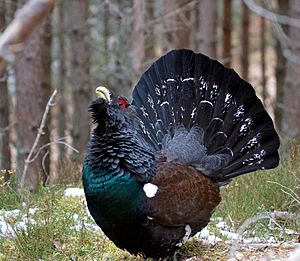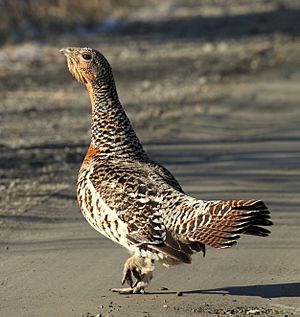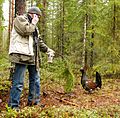Western capercaillie facts for kids
Quick facts for kids Western capercaillie |
|
|---|---|
 |
|
| Male (cock) | |
 |
|
| Female (hen) | |
| Conservation status | |
| Scientific classification | |
| Genus: |
Tetrao
|
| Species: |
urogallus
|
 |
|
| Range of the western capercaillie | |
 |
|
| Distribution in Europe | |
The western capercaillie (Tetrao urogallus) is a large bird that belongs to the grouse family. It is also known as the Eurasian capercaillie, wood grouse, or just capercaillie. These birds are found across parts of Europe and Asia. They are known for looking quite different between males and females, which is called sexual dimorphism. The western capercaillie is currently listed as a least concern species, meaning it is not considered endangered right now.
Contents
What is a Capercaillie?
The western capercaillie is the largest member of the grouse family. Grouse are a group of birds that live mostly on the ground in forests and open areas. Capercaillies are famous for their impressive size and the unique sounds they make, especially during their mating season.
Appearance and Size
Capercaillies are big birds. Males are much larger and more colorful than females.
Male Capercaillie (Cock)
Male capercaillies, called cocks, are very striking. They can weigh between 3.3 and 14 pounds (1.5 to 6.5 kg). They are about 29 to 44 inches (74 to 112 cm) long. Their feathers are mostly dark grey or black, with a metallic green shine on their chest. They have a bright red patch of skin above each eye, called a "comb." Their tail feathers are long and fan-shaped.
Female Capercaillie (Hen)
Female capercaillies, called hens, are smaller and have more camouflaged feathers. They usually weigh between 1.6 and 4.4 pounds (0.7 to 2 kg). They are about 22 to 25 inches (55 to 64 cm) long. Their feathers are a mix of brown, orange, black, and white. This helps them blend in with their surroundings, especially when they are nesting.
Where Capercaillies Live (Habitat)
Western capercaillies live in large, old forests. They prefer forests with lots of pine trees, fir trees, and other conifers. These forests often have open areas with blueberries and heather, which are important food sources. They need quiet places with little human disturbance.
Geographic Range
You can find western capercaillies in many parts of Europe and Asia. Their range stretches from Scotland and parts of Spain in the west, across Scandinavia, Central Europe, and Eastern Europe, all the way to Russia and parts of Siberia in the east.
What Capercaillies Eat (Diet)
Capercaillies are mostly herbivores, meaning they eat plants. Their diet changes with the seasons.
Winter Diet
In winter, when other food is scarce, capercaillies mostly eat pine needles. They have a special digestive system that helps them break down tough plant material. They also eat buds and twigs from other trees.
Summer Diet
In spring and summer, their diet is more varied. They eat leaves, shoots, berries (like blueberries and cranberries), and insects. Young chicks especially need insects for protein to grow quickly.
Capercaillie Life Cycle and Reproduction
The breeding season for capercaillies is a very interesting time. It usually happens in spring, from March to May.
Mating Rituals (Lekking)
Male capercaillies gather in special open areas in the forest called "leks." Here, they perform elaborate displays to attract females. The male will fan his tail, puff out his chest, and make loud, bubbling calls. He might also strut around and even fight with other males to show off his strength. These displays happen early in the morning.
Nests and Chicks
After mating, the female builds a nest on the ground. It's usually a shallow scrape hidden under a bush or tree. She lays about 5 to 12 eggs. The eggs are yellowish with brown spots. The female incubates the eggs by herself for about 26 to 28 days.
Once the chicks hatch, they are able to walk and feed themselves almost immediately. They are covered in downy feathers. The mother hen takes care of them, leading them to food and protecting them from predators. The chicks grow quickly and can fly short distances within a few weeks.
Conservation Status
The western capercaillie is currently listed as a species of "Least Concern" by the International Union for Conservation of Nature (IUCN). This means that, globally, their population is not in immediate danger of extinction.
However, in some parts of their range, their numbers have declined. This is often due to habitat loss, changes in forest management, and human disturbance. Conservation efforts are in place in many areas to protect their forest habitats and ensure their populations remain healthy.
Images for kids
See also
 In Spanish: Urogallo común para niños
In Spanish: Urogallo común para niños








